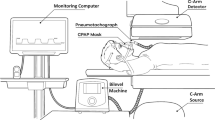Abstract
Background
Quantitative CT shows promise as an outcome measure for cystic fibrosis (CF) lung disease in infancy, but must be accomplished at a dose as low as reasonably achievable.
Objective
To determine the feasibility of ultra-low-dose CT for quantitative measurements of airway dimensions.
Materials and methods
Two juvenile pigs were anesthetized and their lungs scanned at 25 cm H2O face-mask pressure in apnoea using beam currents of 5, 10, 20, 40 and 100 mAs. The lumen diameters and wall thicknesses of matched airways (n=22) at each dose were measured by two observers using validated software. Measurement variability at each dose was compared to that at 100 mAs (reference dose) for large and small airways (lumen diameter <2.5 mm).
Results
Lowering CT dose (mAs) affected measurement variability for lumen diameter of small and large airways (P<0.001) and for wall thickness of small (P<0.001), but not large (P=0.63), airways. To obtain the same measurement variability at 5 mAs as at 100 mAs, four to six small airways or one to three large airways have to be measured and averaged.
Conclusion
Quantitative airway measurements are feasible on images obtained at as low as 5 mAs, but more airways need to be measured to compensate for greater measurement variability.


Similar content being viewed by others
References
de Jong PA, Ottink MD, Robben SG, et al (2004) Pulmonary disease assessment in cystic fibrosis: comparison of CT scoring systems and value of bronchial and arterial dimension measurements. Radiology 231:434–439
de Jong PA, Nakano Y, Hop WC, et al (2005) Changes in airway dimensions on computed tomography scans of children with cystic fibrosis. Am J Respir Crit Care Med 172:218–224
Long FR, Williams RS, Castile RG (2004) Structural airway abnormalities in infants and young children with cystic fibrosis. J Pediatr 144:154–161
de Jong PA, Lindblad A, Rubin L, et al (2006) Progression of lung disease on computed tomography and pulmonary function tests in children and adults with cystic fibrosis. Thorax 61:80–85
de Jong PA, Nakano Y, Lequin MH, et al (2004) Progressive damage on high resolution computed tomography despite stable lung function in cystic fibrosis. Eur Respir J 23:93–97
Brody AS, Tiddens HA, Castile RG, et al (2005) Computed tomography in the evaluation of cystic fibrosis lung disease. Am J Respir Crit Care Med 172:1246–1252
Robinson TE (2004) High-resolution CT scanning: potential outcome measure. Curr Opin Pulm Med 10:537–541
de Jong PA, Mayo JR, Golmohammadi K, et al (2006) Estimation of cancer mortality associated with repetitive computed tomography scanning. Am J Respir Crit Care Med 173:199–203
de Jong PA, Nakano Y, Lequin MH, et al (2006) Dose reduction for CT in children with cystic fibrosis: is it feasible to reduce the number of images per scan? Pediatr Radiol 36:50–53
Brenner D, Elliston C, Hall E, et al (2001) Estimated risks of radiation-induced fatal cancer from pediatric CT. AJR 176:289–296
Brenner DJ (2002) Estimating cancer risks from pediatric CT: going from the qualitative to the quantitative. Pediatr Radiol 32:228–233; discussion 242–244
Mayo JR, Aldrich J, Muller NL (2003) Radiation exposure at chest CT: a statement of the Fleischner Society. Radiology 228:15–21
Slovis TL (2002) The ALARA concept in pediatric CT: myth or reality? Radiology 223:5–6
Long FR, Castile RG, Brody AS, et al (1999) Lungs in infants and young children: improved thin-section CT with a noninvasive controlled-ventilation technique – initial experience. Radiology 212:588–593
Nakano Y, Whittall KP, Kalloger SE, et al (2002) Development and validation of human airway analysis algorithm using multidetector row CT. Proceedings of SPIE 4683:460–469
Nakano Y, Muro S, Sakai H, et al (2000) Computed tomographic measurements of airway dimensions and emphysema in smokers. Correlation with lung function. Am J Respir Crit Care Med 162(3 Pt 1):1102–1108
Nakano Y, Wong JC, de Jong PA, et al (2005) The prediction of small airway dimensions using computed tomography. Am J Respir Crit Care Med 171:142–146
de Jong PA, Long FR, Wong JC, et al (2006) Computed tomographic estimation of lung dimensions throughout the growth period. Eur Respir J 27:261–267
Coxson HO, Mayo JR, Behzad H, et al (1995) Measurement of lung expansion with computed tomography and comparison with quantitative histology. J Appl Physiol 79:1525–1530
Coxson HO, Rogers RM, Whittall KP, et al (1999) A quantification of the lung surface area in emphysema using computed tomography. Am J Respir Crit Care Med 159:851–856
Bland JM, Altman DG (1986) Statistical methods for assessing agreement between two methods of clinical measurement. Lancet 1(8476):307–310
Castile RG, Iram D, McCoy KS (2004) Gas trapping in normal infants and in infants with cystic fibrosis. Pediatr Pulmonol 37:461–469
Long FR (2005) Imaging evolution of airway disorders in children. Radiol Clin North Am 43:371–389
Acknowledgements
The authors want to express their thanks to Robert Short and Lisa Stout for assistance with the CT scanning and Harvey Coxson and Ahn-Tuan Tran of the Vancouver General Hospital (Vancouver, BC, Canada) for their invaluable expertise with quantitative CT analysis and help with measuring airway–artery pairs. The authors are also indebted to Gary Phillips of the Biostatistical Department of Ohio State University who performed the statistical analyses.
Author information
Authors and Affiliations
Corresponding author
Rights and permissions
About this article
Cite this article
de Jong, P.A., Long, F.R. & Nakano, Y. Computed tomography dose and variability of airway dimension measurements: how low can we go?. Pediatr Radiol 36, 1043–1047 (2006). https://doi.org/10.1007/s00247-006-0264-5
Received:
Revised:
Accepted:
Published:
Issue Date:
DOI: https://doi.org/10.1007/s00247-006-0264-5




